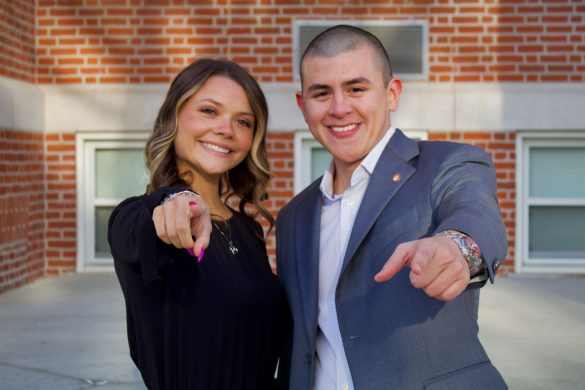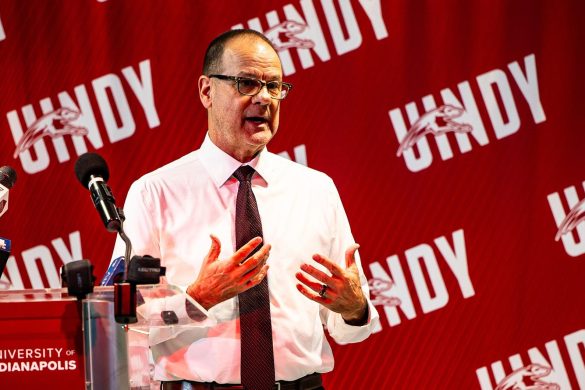As the issues of air pollution and climate change have become prevalent topics of discussion in the political and social spheres, so, too, has the issue of clean, renewable energy.
While some see these issues as national or global problems, they hit closer to home than may be recognized. A recent article in USA Today claimed that Evansville, Ind., is one of the worst cities in the country in terms of air pollution because of a large coal-fired power plant nearby. Former Indianapolis Mayor Greg Ballard used this article and other examples to encourage college students from the University of Indianapolis and Indiana University-Purdue University Indianapolis to join his internship program, the Indiana Advanced Energy Plan.
Ballard called upon students of all majors to join the Indiana Advanced Energy Plan to bring a more realistic and varied voice to the way students view clean energy. The internship program consists of 10 UIndy students and two IUPUI students, with fields of study varying from environmental science to art.
“We have students from an unbelievable number of disciplines,” Ballard said. “Not just science students, we have an art student in there; we have business students. They’re bringing kind of a different angle, too, which is great, and which is real life. That way I think the [internship] students will get a lot out of it and maybe see themselves as somebody who can be an agent of change into the future.”
Ballard said the Advanced Energy Plan is his attempt to portray the opinions of the younger generation to Indiana state legislators, in hopes that they will begin gradually to implement a clean energy plan that encompasses all of Indiana.
“The intention is to put a policy or a plan together and then make sure some way that the legislature knows how these students are feeling,” Ballard said. “We had the utilities committee chair talk to them [the internship students] a couple [of] days ago. The legislature, people making these policies and the regulatory commission need to know how the current generation growing up feels about this. I think that is extremely important.”
According to Ballard, the state of Indiana has an opportunity to bring itself into the future by embracing the possibilities and opportunities brought by clean energy.
“The country is moving in that direction [toward using clean energy], and certainly the younger generation wants to move in that direction,” Ballard said. “I think the adjective itself ‘clean’ says something.”
As an analogy, Ballard compared modern cars to those of the 1970s to point out how far the development of clean energy has come and where it can go in the future.
“If you’re riding a bike behind a car that was driven in the 1970s and smell that, then you ride behind a car that was built in the 2010s, which car do you think is cleaner? It’s not even a close call,” Ballard said. “For those who say, ‘We shouldn’t do this because it’s too expensive.…’ Well, we did do it. We did a lot of it already, and it got better. We all lived, and we all survived. Now there’s another level to get better, and we need to go to that level without causing undue stress. There’s always some disruption, but [we need to do this] with causing as little disruption as possible.”
According to myenergygateway.org, solar and wind power, biomass, geothermal energy and hydroelectric power are some examples of clean energy. However, Ballard said that clean energy has many more layers to it than just dealing with sources of power. He claimed that energy efficiency and infrastructure are key when it comes to truly “clean energy.”
“It [clean energy] is more than just the fuels,” Ballard said. “We can do a lot of good in this country if we can get better at interactivity, building better envelopes, transmission efficiency and more resilience with distributed energy. There are just so many ways of looking at this [other] than just the fuel. That’s really what we are trying to get across to the legislature and the public.”
Although clean energy may improve the state in many ways, Ballard said it undoubtedly brings along the side-effect of lost jobs for those working in conventional energy industries. He said that the probability of lost jobs is not something that he takes lightly in regard to the Advanced Energy Plan.
“There are always vested interests. There are people trying to hang on, and I get that,” Ballard said. “People’s livelihoods are at stake here. There’s just a lot to this. If there are people who are going to be disrupted, then we have to make sure we take care of them along the way, and I emphasize that to the students. Those industries, and the people who work there, are going to be affected, and we need to do the best we can by them—retraining, whatever it might be. We can’t just leave them out to dry and say, ‘I’m sorry you’re on the short end of the stick.’”
UIndy art education major and Indiana Advanced Energy Plan intern Liv Reuter said that most of those in the younger generations are in favor of clean energy, and that expanding clean energy in Indiana is just a matter of convincing legislators and older generations to see the benefits.
“I think people of our age are all for clean energy,” Reuter said. “For the most part, college students are saying, ‘Yeah, that’s great. We should do things that are good for the planet.’ But the generation and [a] couple before us are not so quick to think that way. I think one of our biggest points of opposition is the generation gap. For a lot of people, it’s not even so much that they are against clean energy, it’s just that they are not informed about it.”









